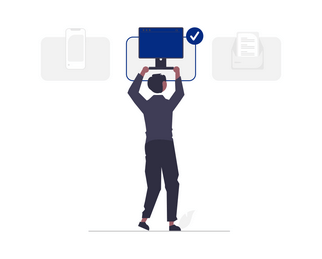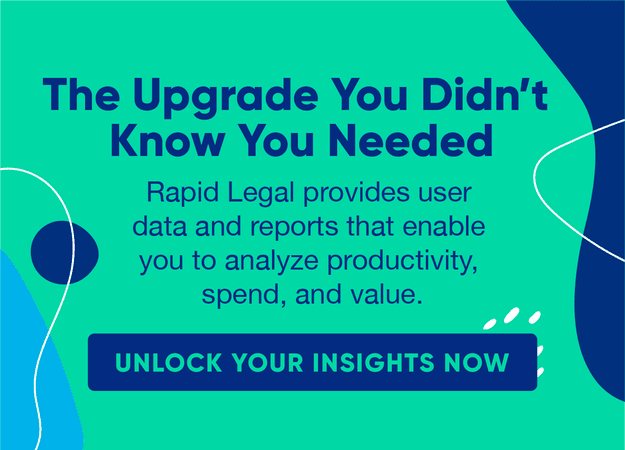
“Digital Transformation is Not about Technology – it’s about strategy and new ways of thinking.”
Digital Transformation Playbook – David L. Rogers
Technology alone isn’t very good at overcoming inertia. Getting the most out of technology in a way that helps a law firm move forward and achieve its objectives requires careful planning and input from stakeholders across the firm, as well as the expertise and deep domain experience of the firm’s technology vendors. If ever there was a time when law firms needed to explore and leverage the full capabilities of legal technologies to remain competitive it is now, while a pandemic and industry dynamics force law firms to innovate their way onto solid footing in a rapidly changing environment.
This article examines how law firms can strategically plan and operationalize the full potential of their technology; assuring their ability to capitalize on the operational advantages and data insights technology can offer in support of the firm’s business strategies and objectives.

Adjusting to a rapidly changing industry
Challenges and competitive pressures on the legal profession that would have been difficult to imagine 20 years ago now bear down on law firms across the landscape. Factors that challenge and can threaten a law firm’s survival include law firm mergers, growth in outsourcing legal services, pricing pressures, competitive business models, and increased client demands.
That’s only part of the picture. There are even more challenges rising from changes in workforce characteristics and evolving technologies.
Some of them include:
- Multi-generational workforce, shift to remote working or a hybrid model
- Exponential growth in volume and types of electronic data
- Court eFiling; law firm automation; client collaboration; new technologies (AI, SaaS, Analytics)
Not every law firm has dealt with all these factors, but few have escaped them altogether.

Putting Technology Into Action
Looking to technology as an answer to these problems may be tempting but would not ultimately provide the full answer. Technology on its own is simply an enablement. Operated as part of sound business strategies and involved firm stakeholders, however, technology can take you to the moon and back.
The first step to getting technology to do the heavy lifting it was designed for is planning. Great technologies come and go but planning is always in style, and essential for getting the full set of capabilities and advantages technology solutions can offer.
Harnessing Strategic Thinking and Organizational Agility
Before technology can optimally serve a law firm’s needs, the firm must engage its strategic thinking.
It should define and challenge its underlying core assumptions and ardently seek to uncover blind spots.
It should also assess the organization’s readiness:
- Who are all the stakeholders?
- What are you trying to achieve? Goals? Objectives? Success Criteria?
- How will you decide what to invest in, and is budget available?
- If other departments are impacted, are they willing to change? Is there cross-organizational support and executive sponsorship?
- What does the organization and staff need to support the roll-out and ensure success?
- Plan and timing?
The legacy organization must be ready to make change happen, and at a rapid pace. Without organization agility, failure is imminent.
Even the most successful companies struggle with adapting their strategic thinking to think differently about every aspect of their strategy – customers, competition, data, innovation, and value.
It may be useful to conduct an audit of your firm’s readiness for the new technology.
Some needs can be uncovered by looking at a firm’s vision, strategies, and plans, including needs related to client matters, business processes, and practice areas. Getting a handle on the full scope of needs requires input from everyone.
By “everyone” we mean law firm staff members who represent an array of disciplines and can contribute expertise relative to the technology being implemented.
Is it really necessary to involve all those disciplines?
Yes, and for good reason.

When you don’t know what you don’t know, ask someone else
Taking on a new technology is not unlike taking on a new employee. Just as human resources departments have a model for making new hires, law firm business models should have a model for acquiring and deploying new technologies. Each model uses specific questions to reveal strengths and weaknesses.
In a law firm, this vetting process should gather individuals from across the organization who possess multidisciplinary expertise to “depose” the legal technology and legal technology vendor.
Why does this approach work?
It’s simple. Let’s look at eFiling and service of process through the eyes of “financial people.” Looking at a new technology through the lens of finance and accounting professionals, you gain insights squarely related to the technology’s finance-specific features or even if not a finance solution, it may have impact to cost-related outcomes for the business.
In the case of data provided by a litigation support service provider, the finance and accounting staff members may notice a system integration between the provider and the firm that can automate reconciliation and allocation of payments to clients. On their recommendation, this process becomes part of the business model which, in turn, makes the firm more efficient.
Did it actually happen?
If you’re wondering whether law firms in the real world use these measure to their advantage the answer is, “Yes.”
In fact, one Los Angeles area law firm used this exact approach to streamline its accounting and save the cost of one full-time employee.
A critical key in leveraging this technology strategically was the daily transfer of order and payment details from the customer relationship management (CRM) system used by the firm’s litigation support service provider directly to the law firm’s CRM.
The success owed to involving multiple stakeholders in the planning who understood the law firm’s needs, recognized an opportunity for technology to satisfy those needs, and turned to technology that met their requirements.
Hard to believe? Read the case study: How This Law Firm Leverages a System With Rapid Legal to Improve Cost Control and Gain Efficiencies.
When it Comes to Data: Think Differently and Think Often
Data adds significant value from within the framework of a law firm’s business model. Data can help a firm save money and lower certain types of risk, so when you consider taking on any technology solution you’ll want to ask questions about the data it provides.
Specifically, you’ll want to ask whether the data is sharable and how it can be used to track performance and identify trends.
You’ll especially want to know whether data can be applied to predict trends or outcomes that might occur. To facilitate this kind of business insight you’ll again want to plan strategically and involve stakeholders from throughout the law firm who understand what data is important, and how it can be used to advance the firm’s objectives.
This approach allows decision makers to use data and analyze it so they understand the performance of efforts you’ve already made. This look back will strategically inform the next move forward.
Properly implemented, legal tech solutions will produce data that tells you how well your business is running. With that, you can continue to let the business evolve and move it forward. At that point you can use predictive analytics to move the law firm even further along.
Analytics is making itself a marquee player in the practice of law. Be certain that your firm’s business model is structured to use the power of analytics and data as a revenue generator, to control costs, help utilize staff, and smartly guide many other functions inside a law firm.

Predictive Analytics for Cost Control
If you’d like to do a deep dive into predictive analytics check out this article to learn how business are using it to control costs.
Cure performance issues with data
Predictive analytics is a glamorous term and its role in courtroom litigation was popularized by the film Runaway Jury. In the trenches of a firm’s day-to-day operations, however, the more routine use of data is less glittery but no less important.
For example, data about the performance of common litigation support services such as court filing, eFiling, and service of process all can help gage the performance of vendors. It is also common to use data to monitor certain litigation support services and know whether they are being delivered as promised.
This information can help firms operate more efficiently and, more importantly, keep more of the revenue they earn. Not all law firms, however, have this data.

This is where a litigation support service provider that provides court filing, service of processes, and other critical services can help. They can collect these types of data and provide it to law firms in regular reports. For example, a firm may want to perform an analysis about key services such as electronic court filing. A firm can use the data in the litigation support service provider’s eFiling reports to evaluate turnaround times and rejection rates, and know whether it needs to course correct.
Similar data can be pulled from a litigation support service provider to measure service of process performance. This data enables a firm to track service level distribution, orders by type, and service of process orders by pricing zone. It’s important for a firm’s business model to use these data sets as cost control measures.
As an example, a firm can examine service of process orders by pricing zone to predict whether the cost of service of process in certain locales may be untenable. The firm may also use the reports to gage the vendor’s performance or the law firm’s own internal performance.
When a law firm searches for a litigation support service provider, its business model should stipulate that a provider can deliver these reports.
4 ways your firm’s business model can use sharable data:
- Service level distribution
- Orders by type
- Service of process orders by pricing zone
- Service of process performance
Read Technology Your Process Server Should Be Using and learn how these reports can save money for your law firm!

Want to lower rejection rates for your electronic court filings? This article explains how. Read it: Common Pitfalls for Court Filing Rejections and How to Avoid Them.
Onward and upward
There is power in planning and expertise and uniting all of the key stakeholders in a technology acquisition and deployment. The success of that acquisition hinges on more than simply having a sound business model. It also requires developing and maintaining strategic best practices that move the law firm toward key business outcomes.
The thing to remember about introducing technology to a law firm is this: Technology on its own is just an enablement, but under the guidance of a well-structured business model and involving key firm stakeholders, technology can take you to the moon and back. And, in many cases, the fuel for that trip will be data that helps you continually leverage that technology and plot the course forward.
Learn how you can get the greatest value from the technology and data you already have. Set up a consultation with a Rapid Legal account executive and learn how. Book a demo or schedule a call now.
Get Started Today
Spend more time on billable client hours and less time tracking down conformed copies and proofs of service.

